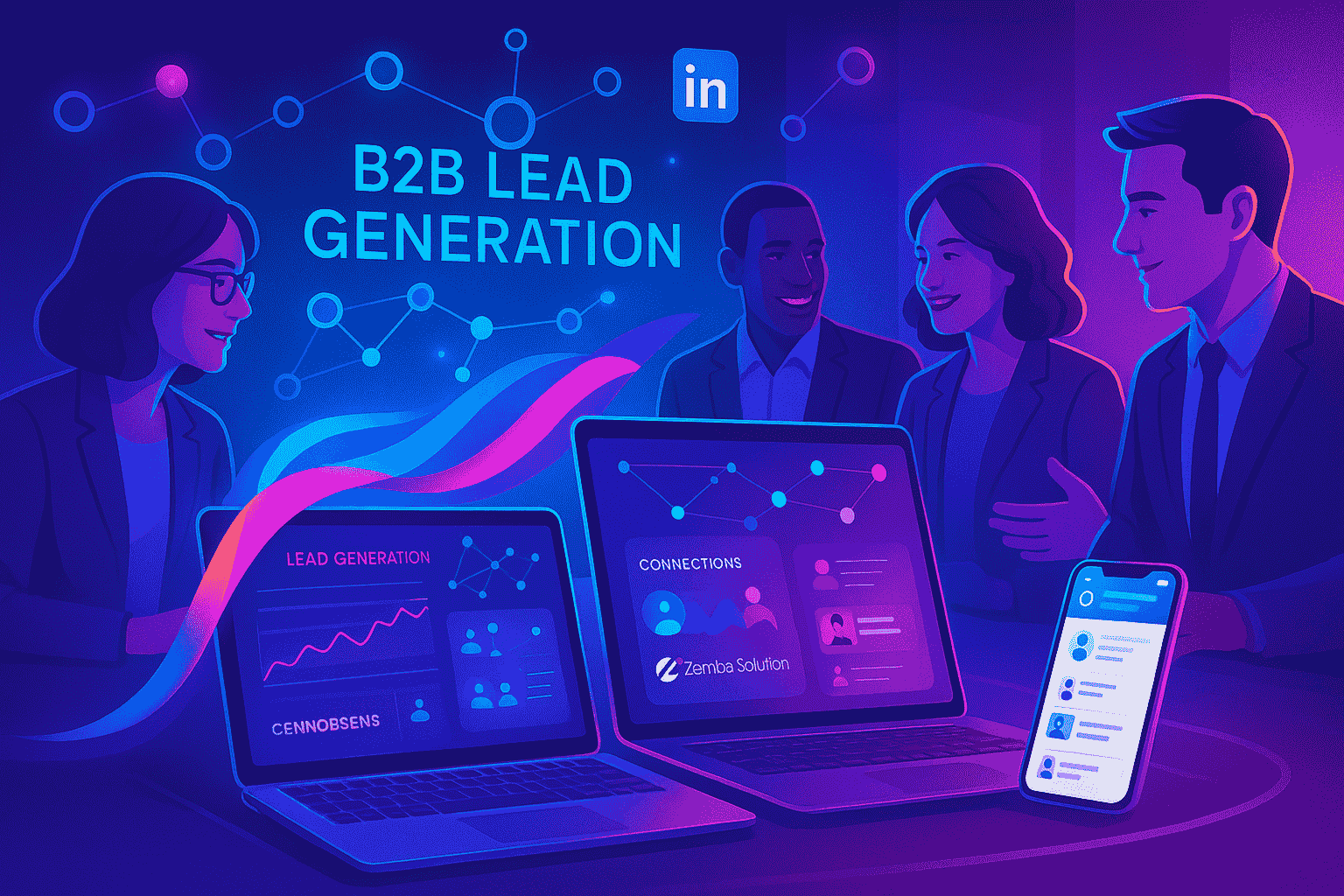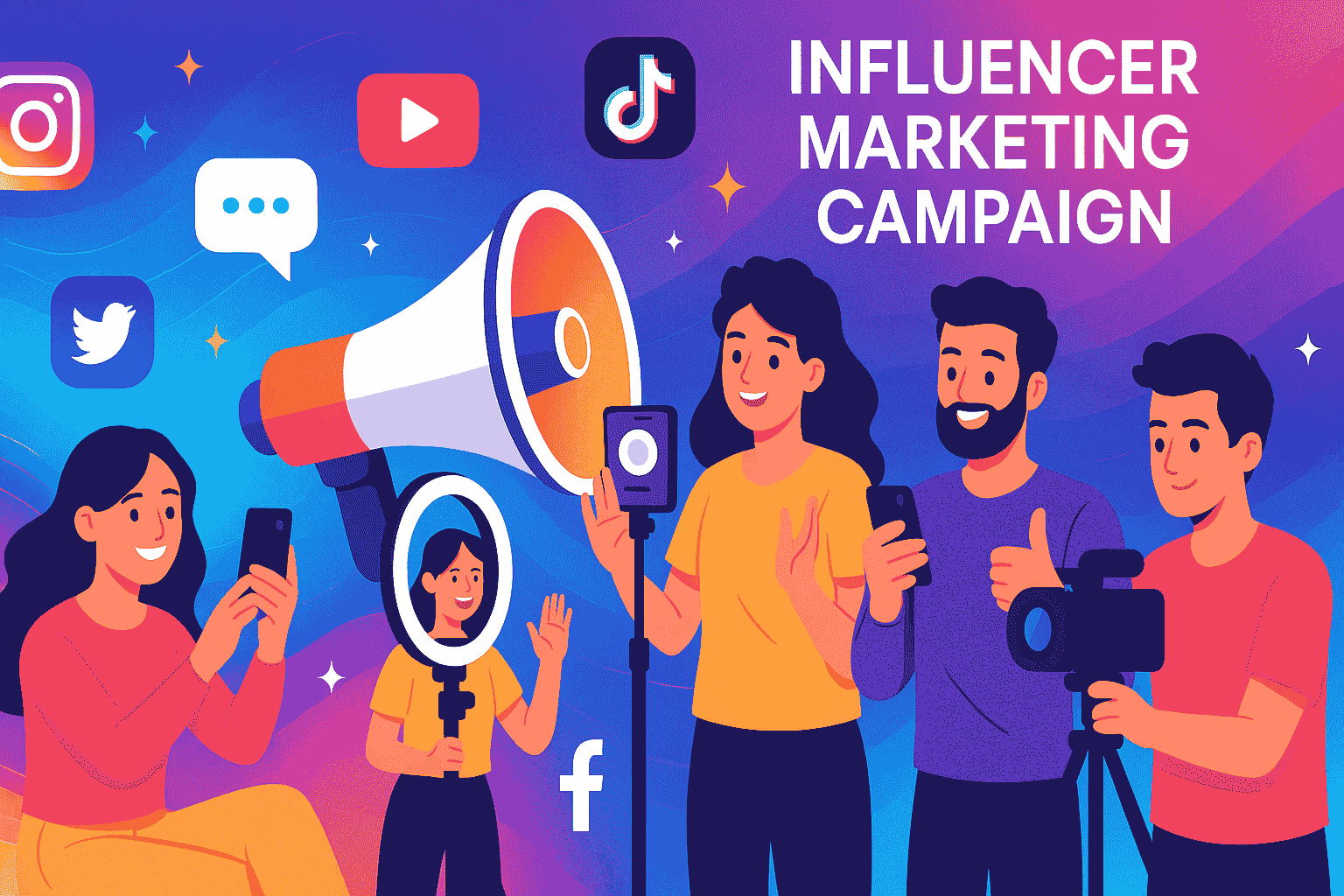An influencer marketing campaign is one of the most powerful ways to reach new audiences, build trust, and drive real business results in 2025. But with so many brands competing for attention, how do you create an influencer marketing campaign that truly stands out and delivers ROI?
This in-depth guide will show you how to create a winning influencer marketing campaign step by step, with actionable strategies, real-world examples, and the latest best practices for success.
What is an Influencer Marketing Campaign?
An influencer marketing campaign is a strategic partnership between a brand and one or more influencers to promote products, services, or brand messages to a targeted audience. Influencers use their platforms—such as Instagram, YouTube, TikTok, LinkedIn, or blogs—to create authentic content that resonates with their followers.
Key elements of an influencer marketing campaign:
- Clear goals and KPIs
- The right influencer(s) for your brand
- Creative, authentic content
- Measurable results
Influencer marketing campaigns can be one-off promotions, long-term partnerships, or even ambassador programs.
Why Influencer Marketing Campaigns Work in 2025
Influencer marketing campaigns are effective because they leverage trust, authenticity, and reach. Here’s why they work:
- Trust: 61% of consumers trust influencer recommendations over brand ads.
- Authenticity: Influencers create content that feels real and relatable.
- Targeted Reach: Influencers have niche audiences that match your ideal customer.
- Content Creation: Influencers produce high-quality, engaging content for your brand.
- Social Proof: Seeing real people use your product builds credibility.
According to Statista, the influencer marketing industry is projected to reach 24 billion by 2025, with brands seeing an average ROI of 24 billion by 2025, with brands seeing an average ROI of 5.78 for every $1 spent.

7 Steps to Create a Winning Influencer Marketing Campaign
1. Set Clear Goals and KPIs
Start by defining what you want to achieve with your influencer marketing campaign. Common goals include:
- Brand awareness
- Lead generation
- Sales or conversions
- Social media growth
- Content creation
KPIs to track:
- Reach and impressions
- Engagement rate (likes, comments, shares)
- Click-through rate (CTR)
- Conversions or sales
- Follower growth
Action Step:
Write down your top 1-2 goals and how you’ll measure success.
2. Define Your Target Audience
Who do you want to reach with your influencer marketing campaign?
- Age, gender, location
- Interests and values
- Social media platforms they use
- Pain points and aspirations
Action Step:
Create a detailed buyer persona for your campaign.
3. Choose the Right Influencer Type
There are several types of influencers to consider for your influencer marketing campaign:
- Nano-influencers (1K–10K followers): Highly engaged, niche audiences, affordable.
- Micro-influencers (10K–100K): Great for targeted reach and authenticity.
- Macro-influencers (100K–1M): Larger reach, more expensive, but still relatable.
- Mega-influencers (1M+): Celebrity status, massive reach, high cost.
- Industry experts/thought leaders: Trusted voices in B2B or specialized fields.
Action Step:
Decide which influencer type(s) best fit your goals and budget.
4. Find and Vet Influencers
Finding the right influencer is crucial for a successful influencer marketing campaign.
How to find influencers:
- Search relevant hashtags on Instagram, TikTok, and Twitter.
- Use influencer marketing platforms (AspireIQ, Upfluence, CreatorIQ, Influencity).
- Check your own followers for potential brand fans.
- Look for bloggers and YouTubers in your niche.
How to vet influencers:
- Check engagement rate (not just follower count).
- Review content quality and style.
- Analyze audience demographics (use tools or request a media kit).
- Look for past brand partnerships and authenticity.
- Watch for fake followers or engagement.
Action Step:
Create a shortlist of 10–20 potential influencers for your campaign.
5. Craft a Compelling Influencer Marketing Campaign Brief
A clear brief sets expectations and inspires creativity.
What to include:
- Campaign goals and KPIs
- Brand background and values
- Key messages and product info
- Content guidelines (format, tone, hashtags, tags)
- Deliverables (number of posts, stories, videos, etc.)
- Timeline and deadlines
- Compensation and legal requirements (disclosure, usage rights)
Action Step:
Draft your influencer marketing campaign brief and share it with your chosen influencers.
6. Collaborate and Co-Create Content
The best influencer marketing campaigns are a collaboration. Trust influencers to create content that resonates with their audience, but provide clear guidelines.
Tips for co-creation:
- Encourage creativity and authenticity.
- Approve content before it goes live (if needed).
- Provide product samples or experiences.
- Offer feedback and support.
Action Step:
Schedule a kickoff call or send a welcome package to your influencers.
7. Launch, Track, and Optimize Your Campaign
Once your influencer marketing campaign goes live:
- Monitor posts for accuracy and compliance.
- Engage with influencer content (like, comment, share).
- Track KPIs in real time.
- Collect and repurpose influencer content for your own channels.
- Analyze results and optimize for future campaigns.
Action Step:
Create a campaign dashboard to track performance and ROI.

Types of Influencers and Campaigns
Types of Influencers
- Nano-influencers: Best for hyper-local or niche campaigns.
- Micro-influencers: Ideal for targeted reach and high engagement.
- Macro-influencers: Great for brand awareness and larger campaigns.
- Mega-influencers: Best for mass-market products and big launches.
- Employee advocates: Turn your team into brand ambassadors.
- Customer advocates: Feature real customers in your campaign.
Types of Campaigns
- Product launches
- Giveaways and contests
- Unboxing and reviews
- Tutorials and how-tos
- Brand ambassador programs
- Event promotion
- Affiliate and referral campaigns
- Social causes and CSR initiatives
How to Find the Right Influencers
1. Use Influencer Marketing Platforms
- AspireIQ: Search, vet, and manage influencer relationships.
- Upfluence: Find influencers by keyword, audience, and engagement.
- CreatorIQ: Advanced analytics and campaign management.
- Influencity: AI-powered influencer discovery.
2. Manual Search
- Search hashtags and keywords on Instagram, TikTok, and YouTube.
- Use Google to find top bloggers and YouTubers in your niche.
- Check your own followers for potential brand fans.
3. Analyze Audience and Engagement
- Use tools like HypeAuditor or Social Blade to check for fake followers.
- Review past sponsored content for authenticity and results.
- Request a media kit or audience insights from the influencer.
4. Build Relationships
- Engage with influencers’ content before reaching out.
- Personalize your outreach and explain why you’re a good fit.
Crafting Your Influencer Marketing Campaign Brief
A great brief is the foundation of a successful influencer marketing campaign.
What to include:
- Campaign overview and objectives
- Key messages and product info
- Content guidelines (format, tone, hashtags, tags)
- Deliverables and deadlines
- Compensation and payment terms
- Disclosure requirements (#ad, #sponsored)
- Usage rights (can you repurpose content?)
- Contact info and support
Pro Tip:
Keep your brief clear but flexible—allow influencers to add their creative touch.

Influencer Marketing Campaign: Advanced Strategies for 2025
1. Embrace Data-Driven Influencer Selection
In 2025, successful influencer marketing campaigns are built on data, not just gut feeling. Use advanced analytics tools to evaluate potential influencers based on:
- Audience demographics: Ensure their followers match your target market.
- Engagement quality: Look for genuine comments and conversations, not just likes.
- Content performance: Analyze past sponsored posts for reach, engagement, and conversions.
- Brand alignment: Review their values, tone, and previous partnerships.
Pro Tip:
Platforms like HypeAuditor, Upfluence, and CreatorIQ offer deep analytics to help you make informed decisions for your influencer marketing campaign.
2. Co-Create Content with Influencers
The best influencer marketing campaigns are collaborative. Instead of dictating every detail, involve influencers in the creative process. Ask for their ideas, let them share their authentic voice, and encourage them to use their preferred formats—whether that’s Reels, Stories, YouTube Shorts, or blog posts.
Benefits of co-creation:
- Content feels more genuine and less scripted.
- Influencers know what resonates with their audience.
- You’ll get a variety of creative assets to repurpose.
Action Step:
Host a virtual brainstorming session with your influencers before launching your campaign.
3. Leverage User-Generated Content (UGC)
Encourage your influencers’ followers to create and share their own content as part of your influencer marketing campaign. UGC builds trust, expands your reach, and provides you with a library of authentic assets.
How to encourage UGC:
- Run a hashtag challenge or contest.
- Feature the best user posts on your brand’s social channels.
- Offer incentives like discounts, giveaways, or a chance to be featured.
Example:
A beauty brand’s influencer marketing campaign asks followers to post their makeup looks using a branded hashtag. The brand then shares the best looks on its Instagram Stories, creating a sense of community and excitement.
4. Integrate Influencer Content Across All Channels
Don’t limit your influencer marketing campaign to just one platform. Repurpose influencer content for:
- Website landing pages
- Email newsletters
- Paid social ads (with permission)
- In-store displays
- Product packaging
Pro Tip:
Influencer whitelisting allows you to run paid ads from the influencer’s account, leveraging their credibility and audience for even greater reach.
5. Build Long-Term Influencer Partnerships
One-off influencer marketing campaigns can work, but long-term partnerships deliver better results. When influencers become true brand advocates, their recommendations carry more weight and their content feels more authentic.
How to build long-term relationships:
- Offer exclusive perks or early access to new products.
- Invite influencers to brand events or product launches.
- Provide regular feedback and celebrate their successes.
- Feature them in your brand’s own content and channels.
Example:
A fitness apparel brand partners with a group of micro-influencers for a year-long ambassador program, providing them with monthly product drops, exclusive event invites, and a commission on sales.
6. Use Influencer Marketing for Product Development
Influencers are often trendsetters and have a deep understanding of their audience’s needs. Involve them in your product development process:
- Ask for feedback on prototypes or new features.
- Co-create limited-edition products or collections.
- Use influencer insights to refine your messaging and positioning.
Example:
A food brand works with vegan influencers to develop a new plant-based snack, using their input on flavor, packaging, and marketing.
7. Focus on Diversity and Inclusion
Modern consumers expect brands to reflect and celebrate diversity. Ensure your influencer marketing campaign includes voices from different backgrounds, cultures, and perspectives.
Action Steps:
- Partner with influencers from underrepresented groups.
- Highlight diverse stories and experiences in your campaign.
- Avoid tokenism—make diversity a core value, not just a checkbox.
Influencer Marketing Campaigns: Legal and Ethical Considerations
1. Disclosure and Transparency
Always require influencers to disclose sponsored content using #ad, #sponsored, or platform-specific tools. This is not just ethical—it’s the law in many countries.
2. Contracts and Agreements
Protect your brand and your influencers by using clear contracts that outline:
- Deliverables and deadlines
- Compensation and payment terms
- Content usage rights
- Disclosure requirements
- Cancellation and dispute resolution terms
3. Brand Safety
Review influencer content for alignment with your brand values. Monitor for any controversial or off-brand posts that could impact your reputation.
4. Data Privacy
If your influencer marketing campaign collects user data (e.g., through contests or signups), ensure you comply with GDPR, CCPA, and other privacy regulations.
Influencer Marketing Campaigns: Measuring Long-Term Impact
While immediate results like reach and engagement are important, the best influencer marketing campaigns deliver long-term value:
- Brand affinity: Are people talking about your brand more positively?
- Customer loyalty: Do influencer-driven customers become repeat buyers?
- SEO benefits: Do influencer blog posts and backlinks improve your search rankings?
- Community growth: Are you building a loyal audience that advocates for your brand?
Pro Tip:
Track brand mentions, sentiment, and share of voice over time to measure the lasting impact of your influencer marketing campaign.
Influencer Marketing Campaigns: Crisis Management and Recovery
No campaign is immune to challenges. Here’s how to handle common issues:
1. Negative Feedback or Backlash
- Respond quickly and professionally.
- Acknowledge concerns and offer solutions.
- Avoid deleting negative comments unless they violate guidelines.
2. Influencer Controversy
- Have a crisis plan in place.
- Pause or end partnerships if necessary.
- Communicate transparently with your audience.
3. Underperforming Campaigns
- Analyze what went wrong (audience mismatch, weak creative, poor timing).
- Gather feedback from influencers and your team.
- Use insights to optimize future campaigns.
The Future of Influencer Marketing Campaigns
Looking ahead, influencer marketing campaigns will become even more data-driven, authentic, and integrated with other marketing channels. Expect to see:
- AI-powered influencer discovery and campaign optimization
- Deeper integration with social commerce and shoppable content
- More focus on micro-communities and niche audiences
- Greater emphasis on long-term partnerships and brand ambassadorships
- Increased use of video, live streaming, and interactive content
Your Influencer Marketing Campaign Action Plan
- Set clear goals and KPIs.
- Define your target audience and ideal influencer profile.
- Research, vet, and build relationships with influencers.
- Craft a compelling campaign brief and collaborate on creative.
- Launch, monitor, and optimize your campaign in real time.
- Measure both short-term and long-term results.
- Build on your success with ongoing partnerships and new strategies.
Ready to take your brand to the next level? Start planning your influencer marketing campaign today and unlock the power of authentic, data-driven partnerships!
Measuring Influencer Marketing Campaign Success
Key Metrics to Track
- Reach and impressions: How many people saw the content?
- Engagement rate: Likes, comments, shares, saves.
- Click-through rate (CTR): How many clicked your link or CTA?
- Conversions: Sales, signups, downloads, or other desired actions.
- Follower growth: Did your brand gain new followers?
- ROI: Revenue or value generated vs. campaign cost.
Tools for Measurement
- UTM parameters: Track traffic and conversions in Google Analytics.
- Influencer platforms: Many offer built-in analytics dashboards.
- Manual tracking: Collect screenshots and reports from influencers.
Analyzing Results
- Compare results to your original KPIs.
- Identify top-performing influencers and content types.
- Gather feedback from influencers and your team.
- Use insights to optimize future campaigns.
Influencer Marketing Campaign Mistakes to Avoid
- Choosing influencers based only on follower count.
- Not setting clear goals or KPIs.
- Micromanaging content and stifling creativity.
- Ignoring legal requirements (disclosure, contracts).
- Failing to track and measure results.
- Not building long-term relationships with influencers.
- Overlooking micro- and nano-influencers.
- Not repurposing influencer content for your own channels.
- Ignoring negative feedback or crisis management.
- Giving up after one campaign—consistency is key!
Case Studies: Winning Influencer Marketing Campaigns
1. Daniel Wellington (Watches)
Daniel Wellington built a global brand by partnering with thousands of micro-influencers on Instagram. Their influencer marketing campaign focused on authentic, user-generated content and a unique discount code for each influencer. The result? Explosive growth and millions of sales.
2. Glossier (Beauty)
Glossier’s influencer marketing campaign turned everyday customers into brand ambassadors. By encouraging real users to share their experiences, Glossier built a loyal community and generated massive word-of-mouth buzz.
3. Gymshark (Fitness)
Gymshark’s influencer marketing campaign focused on fitness micro-influencers and YouTubers. Their long-term partnerships and event collaborations helped them become one of the fastest-growing fitness brands in the world.
4. HelloFresh (Meal Kits)
HelloFresh used a mix of macro- and micro-influencers on Instagram and YouTube to share unboxing videos, recipes, and discount codes. Their influencer marketing campaign drove thousands of new signups and high engagement.
5. Adobe (B2B/Creative)
Adobe’s influencer marketing campaign partnered with creative professionals and educators to showcase real-world uses of Adobe products. Their content included tutorials, webinars, and social media takeovers, driving both awareness and product adoption.
Advanced Influencer Marketing Campaign Strategies for 2025
- AI-Powered Influencer Discovery: Use AI tools to find the best-fit influencers based on audience data and engagement.
- Long-Term Partnerships: Build ongoing relationships for authentic, consistent content.
- Performance-Based Compensation: Pay influencers based on results (sales, leads, signups).
- Cross-Platform Campaigns: Run campaigns across Instagram, TikTok, YouTube, LinkedIn, and blogs.
- User-Generated Content: Encourage your audience to create and share content for your brand.
- Influencer Whitelisting: Run paid ads from influencer accounts for higher trust and reach.
- Virtual and Augmented Reality: Use AR filters, virtual events, and immersive experiences.
- Diversity and Inclusion: Partner with influencers from diverse backgrounds to reach new audiences.
- Social Commerce: Enable direct purchases from influencer posts and stories.
Influencer Marketing Campaigns for Different Industries
E-commerce
- Product launches, unboxings, and reviews
- Affiliate and referral programs
- Instagram and TikTok shopping features
B2B
- LinkedIn thought leadership campaigns
- Webinars and virtual events with industry experts
- Case studies and testimonials
Health and Wellness
- Fitness challenges and routines
- Nutrition tips and product demos
- Mental health advocacy
Travel and Hospitality
- Destination guides and travel vlogs
- Hotel and experience reviews
- Live streams and virtual tours
Education
- Course reviews and student testimonials
- Study tips and educational content
- Influencer-led webinars and workshops
Top Tools for Influencer Marketing Campaigns
- AspireIQ: Influencer discovery and campaign management
- Upfluence: Search, vet, and manage influencers
- CreatorIQ: Advanced analytics and reporting
- Influencity: AI-powered influencer marketing platform
- HypeAuditor: Audience analysis and fraud detection
- BuzzSumo: Content research and influencer identification
- Traackr: Influencer relationship management
- GRIN: E-commerce influencer marketing platform
Conclusion: Your Next Steps for Influencer Marketing Success
A winning influencer marketing campaign is built on strategy, creativity, and authentic relationships. By setting clear goals, choosing the right influencers, and measuring your results, you can drive real business growth in 2025 and beyond.
Action Steps:
- Define your campaign goals and KPIs.
- Identify and vet the right influencers for your brand.
- Craft a clear, inspiring campaign brief.
- Collaborate with influencers to create authentic content.
- Launch, track, and optimize your campaign for maximum ROI.
- Build long-term relationships for ongoing success.
Ready to grow your brand? Start planning your influencer marketing campaign today and watch your business thrive!
Frequently Asked Questions
Q: How much does an influencer marketing campaign cost?
A: Costs vary widely based on influencer type, platform, and deliverables. Micro-influencers may charge 100–100–500 per post, while macro-influencers can charge thousands.
Q: How do I measure ROI for influencer marketing?
A: Track KPIs like reach, engagement, clicks, conversions, and sales. Use UTM links and influencer-specific discount codes.
Q: Should I work with micro- or macro-influencers?
A: Micro-influencers offer higher engagement and authenticity, while macro-influencers provide larger reach. The best campaigns often use a mix.
Q: What platforms are best for influencer marketing?
A: Instagram, TikTok, and YouTube are top choices, but LinkedIn, Twitter, and blogs are great for B2B and niche audiences.
Q: How do I avoid fake influencers?
A: Check engagement rates, audience authenticity, and use tools like HypeAuditor to spot fake followers.
Further Reading
- Statista: Influencer Marketing Industry Data
- HubSpot: Influencer Marketing Guide
- Neil Patel: Influencer Marketing Tips
- AspireIQ: Influencer Marketing Resources
Need Help Elevating Your Digital Brand?
Ready to implement a future-ready brand strategy? Our expert team specializes in crafting compelling online identities that convert browsers into believers.
👉 Contact Us Today for a free 15-minute consultation.


